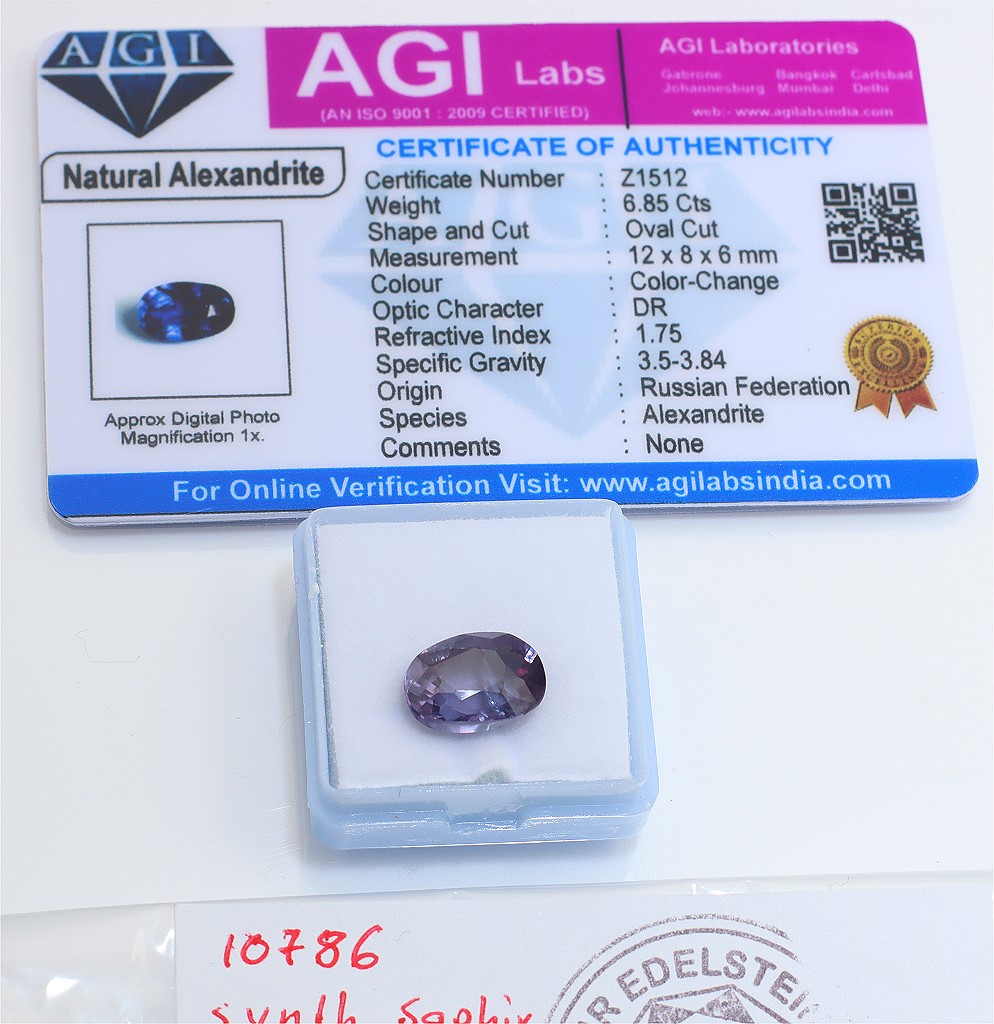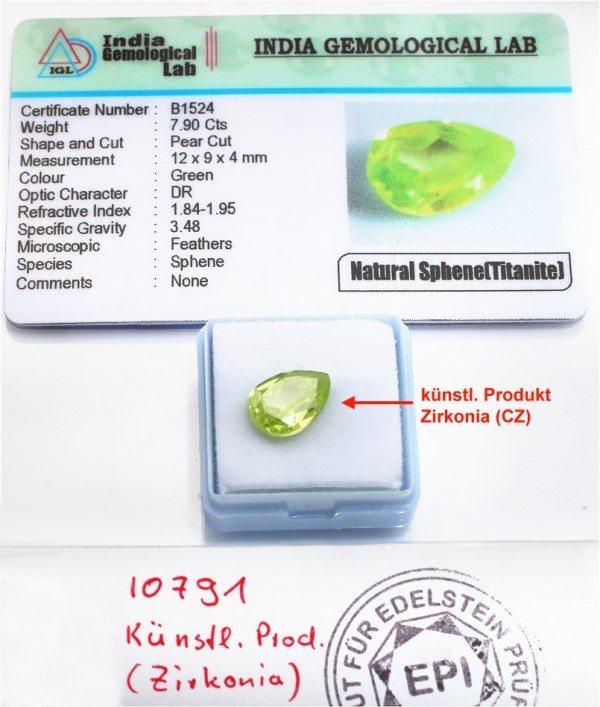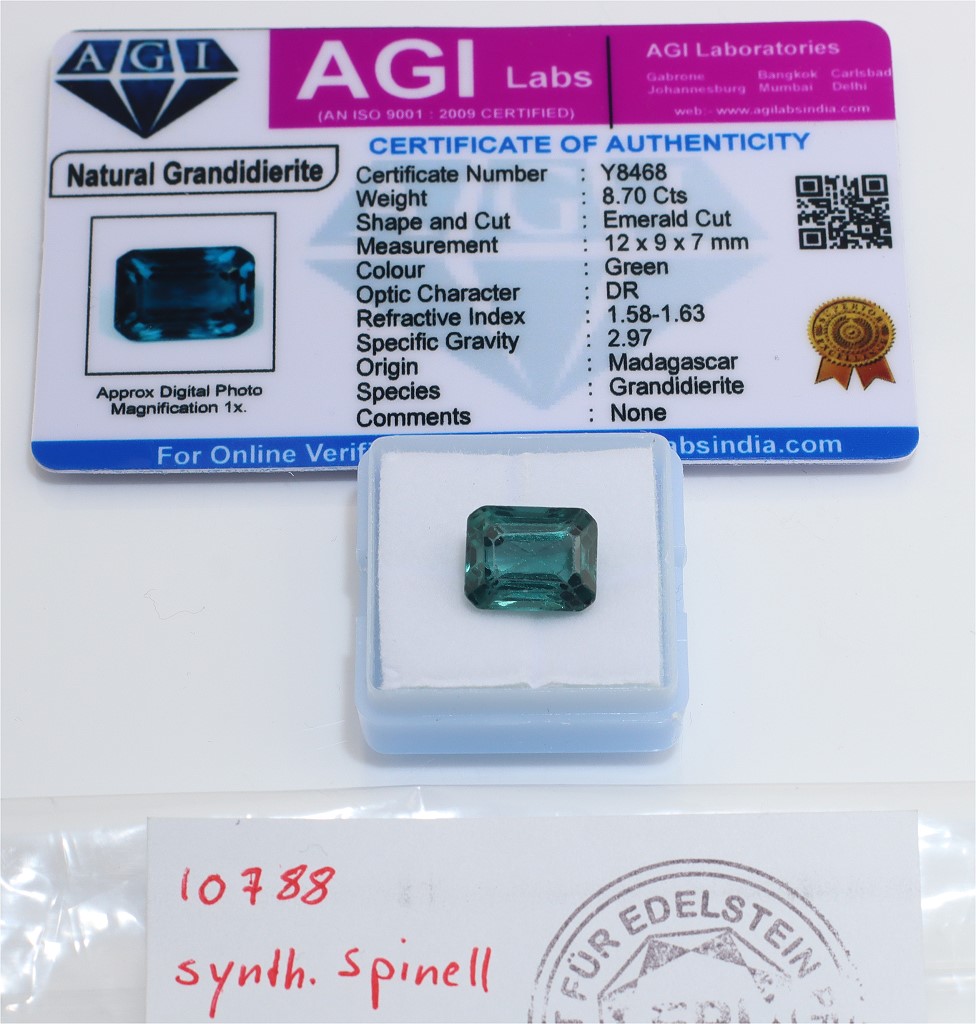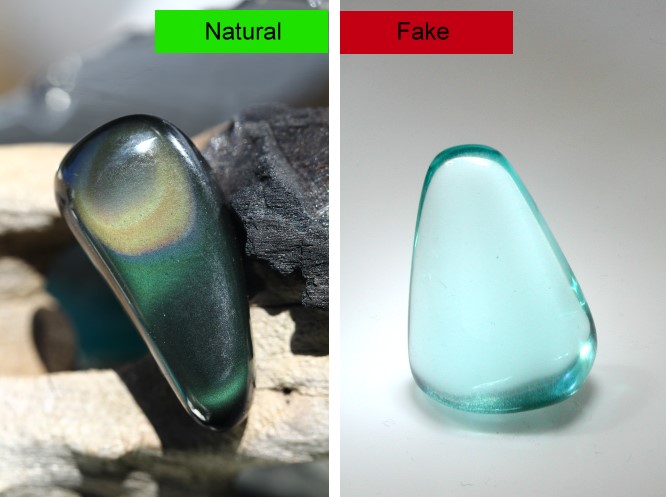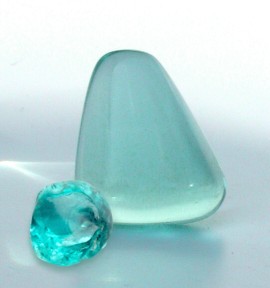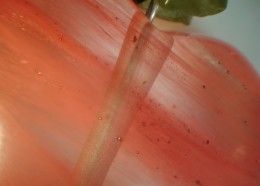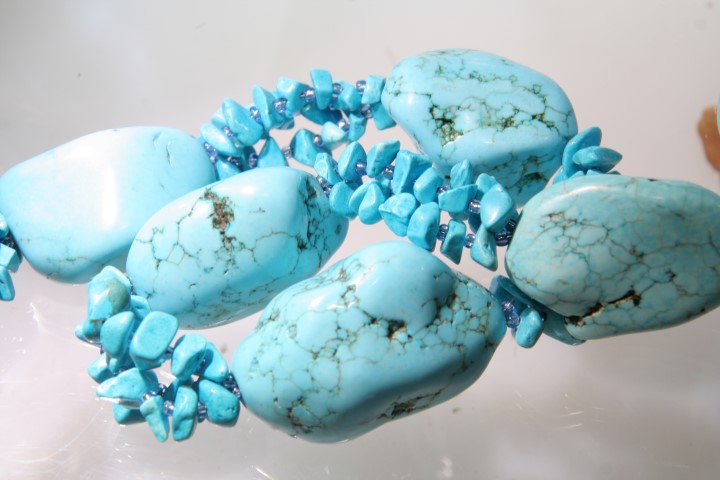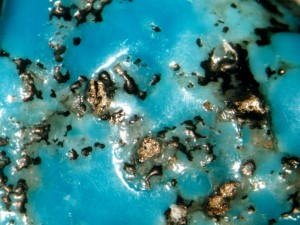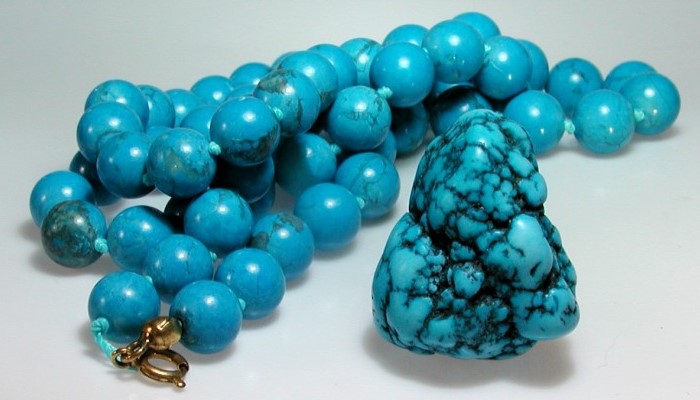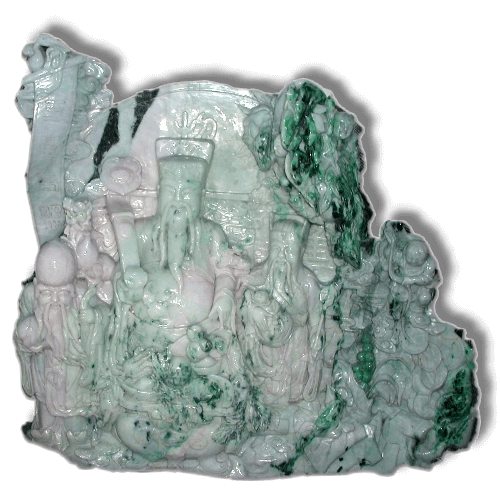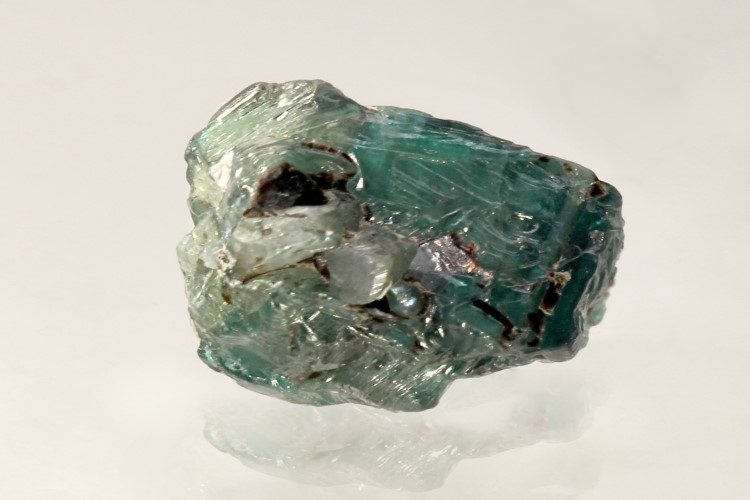Obsidian is a volcanic rock, whose chemical composition corresponds to that of rhyolitic or granitic rocks. It is formed during volcanic eruptions when silicic lava cools down very quickly in air or water. Because of a rapid cooling process the volcanic melt hardly had time to crystallize and solidified as a glassy mass.
Depending on the formation history and the embedded impurities a number of color and structure varieties exist. Commercially available are:
- Common greenish-brown obsidian
- »Black Obsidian« (black due to ore inclusions)
- »Smoky Obsidian« (transparent, smoky obsidian with few ore inclusions)
- »Lamella Obsidian« (transparent, smoky obsidian with lamellar ore layers)
- »Mahogany Obsidian« (black obsidian with brown, iron oxide-rich banding)
- »Snowflake Obsidian« (black obsidian with white spots of crystalising minerals)
- »Apache Tears« (roundish, transparent to black obsidian)
- »Rainbow Obsidian« (black obsidian with colorfully reflecting areas due to mineral inclusions)
- »Gold Obsidian«, »Silver Obsidian« (black obsidian with golden or silver-colored luster due to glass and water inclusions)

»Snowflake Obsidian« is formed from black obsidian, by crystallization of feldspar (sanidine) and quartz (cristobalite, tridymite). In the white areas of the »Snowflake Obsidian« the crystallization process is already in an advanced stage. If the process continues, areas with small, roundish obsidian remnants are formed, which are called »Apache Tears«.

The most beautiful specimens of the obsidian variety »Rainbow Obsidian« come from the provinces of Querétaro and Jalisco in Central Mexico. The magnificent, iridescent play of colors is caused by tiny, aligned minerals (e.g. ilmenite). They refract and reflect the light in a way that colored light phenomena appear in a specific viewing direction.
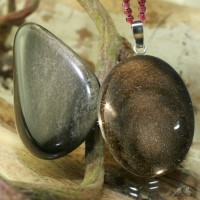
Like »Rainbow Obsidian«, the varieties »Gold Obsidian« and »Silver Obsidian« mainly originate in the provinces of Querétaro and Jalisco in Central Mexico.
During the rapid cooling of the lava, trapped gas and ashes have formed tiny channels which - given the right size and orientation - reflect the light as a golden or silvery shine.
... versus artificial glass
According to CIBJO The World Juwellery Confederation, imitations are products that imitate the appearance of precious stones, gemstones, ornamental stones or organic substances without having their chemical composition and/or their physical properties and/or their structure. In the case of the following products, no naturally occurring counterparts exist, so that they couldn't even be called imitations. Natural obsidian NEVER occurs in the colors transparent blue, red or yellow. These artificial products exist solely due to the inventiveness of humans and have nothing to do with obsidian !
»Blue obsidian« and »green obsidian« which are occasionally mentioned in the mineralogical literature are slightly bluish-gray and greenish-gray obsidians with an unobtrusive appearance. The slightly bluish or greenish coloring can only be observed when light passes through the stone. Non-mineralogists rarely know how natural "blue" and "green" obsidian looks like, that's why various highly transparent artificial aquamarin blue and emerald green products are offered under these names. Their appearance and transparency differ significantly from the natural product.
Glassy slag
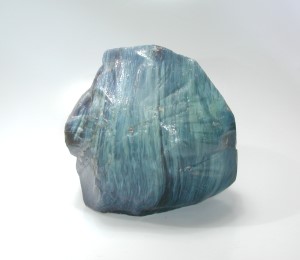
Glassy slag - even if found in nature - is not a natural product
Photo: K. Sieber, www.makrogalerie.de
For years, a light to dark blue or yellowish to green veined glass slag has been tradet with astonishing persistence as "blue obsidian". Initially it was sold as "antique glass", but soon it underwent a misleading metamorphosis into the alleged natural product obsidian. In reality it is a waste product of the iron smelting industry and has nothing to do with obsidian. All over the world exist many big and small disposal sites of this material.
"Green / Red / Yellow Obsidian" | "St. Helens Obsidian"
"Green obsidian" or "St. Helens obsidian" allegedly originates from the eruption of the volcano St. Helens in the USA. The fact that there was no lava flow at all during that eruption does not matter to the profiteers. Sadly this lie is also spread in some esoteric stone books. The manufacturer claims that this product would be manufactured by melting ashes collected from different parts of the volcano. Strange enough the trace elements that are responsible for the coloring of the glasses are not present in the original volcanic ash. The products achieved by melting down ashes from Mt. St. Helens always had a brownish black color. Anyway, an artificially produced product can never be called "obsidian".
"Blue Obsidian" | "Synthetic Obsidian" | "Andara Crystal"
Just as persistent as the "St. Helens glass" is an artificial, aquamarin blue glass product, whose origin is specified as Java (Indonesia). It is offered as "Andara Crystal", "Aqua Lemuria", "Blue obsidian" or "Synthetic obsidian".The latter term is wrong in two senses. According to CIBJO a synthetic product must have essentially the same chemical composition, physical properties and structure as
that of their naturally occurring counterparts. Synthetic glass does not fulfill with this rule. The physical and chemical characteristics of natural obsidian do NOT match those of the synthetic glasses. Even more: there is no natural counterpart. Aquamarin blue obsidian is completely unknown in nature!
Even though this product is sold on Asian markets under the name "synthetic obsidian", in Europe this term is considered to be misleading. This material can be found in the teleshopping sector as well as on mineral fairs (even as tumbled stones). Now and then it is misleadingly offered as "very rare green (or blue) natural obsidian" or as "Volcanic Glass".
"Volcanic Glass"
"Volcanic glass" or "Red Obsidian" are the terms used to characterize a red artificial glass, which is sold mainly as cut goods (for example as bead chains, tumbled stones, etc.). To the naked eye the material looks quite natural. Only when taking a closer look with a magnifying glass, numerous round gas bubbles enclosed in the glass can be spotted. These gas bubbles and many red inclusions make the material translucent to almost opaque, so that it could be mistaken for a natural stone.
However, red obsidian is completely unknown in nature. Glasses in this color are ALWAYS artificial products.
Author: Dipl.-Min. B. Bruder
© INSTITUT FÜR EDELSTEIN PRÜFUNG (EPI)
The millennia-old preference for the sky blue stones also led to a negative superlative: turquoise has been treated and imitated like no other gemstone in the past and present. Even 5,000 years ago the ancient Egyptians produced a ceramic with turquoise glaze made of copper salts. However, today's possibilities of 'enhancements' and imitations go much further.
Matrix induced turquoise
The presence of dark spots and veins is no longer a sign of the authenticity of turquoise. These veins known as "matrix" usually consist of remnants of the parent rock and can contain mica, slate, calcite, hematite and copper oxides. Turquoise with particularly finely drawn matrix lines is called »Spiderweb Turquoise«.
In stabilized and reconstructed turquoise this matrix can be imitated deceptively realistically with ink or black cement which is pressed into the cracks and fissures of the stone. For this purpose, the stone is dipped into a tar-like substance that adheres to the surface. In the subsequent grinding and polishing process, this foreign substance is largely removed. It remains only in the cracks and depressions, which results in a good imitation of the turquoise matrix.
Dyed Magnesite
A popular turquoise imitation which consists of blue dyed magnesite, calcite or very rarely howlite is sometimes traded under the name "Turkenite". More often it is sold as "turqoise" without further comment, or - in it's undyed state - as "white turquoise".
Magnesite can also get an induced matrix to imitate »Spiderweb Turquoise«. Colored howlite is hardly ever used anymore. Because of the rarity of the raw material it has been replaced by colored magnesite.
Pressed Products
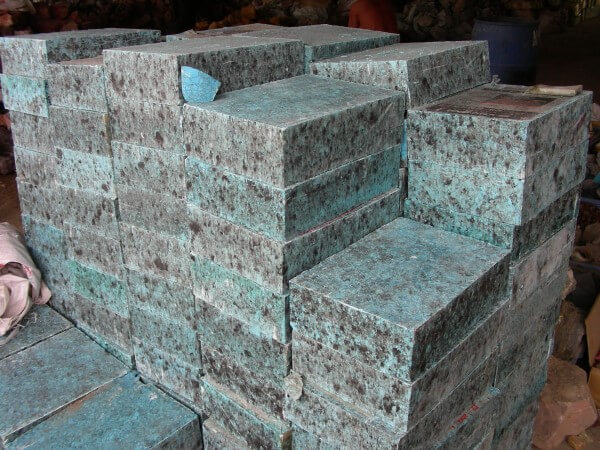
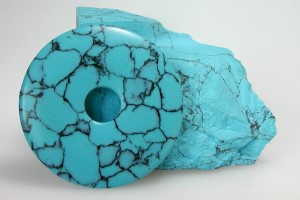
Artificial product modelled on turquoise
So-called "pressed products" are a frequent imitation. The basic material is a cement-like powder which is colored and pressed into rectangular bars with the aid of synthetic granules. The color of these artificial products can be a uniform light blue or contain fine matrix veins. Natural minerals such as pyrite can also be mixed in.
'Neoturquoise', 'Viennese Turquoise', 'Reese Turquoise' (neolite) and 'Gilson Turquoise' are trade names that wrongly contain the word "turquoise". They have nothing to do with genuine turquoise. To distinguish untreated and treated turquoise and some of its imitations the determination of their specific gravity (density) often gives a useful hint.
Author: Dipl.-Min. B. Bruder
© INSTITUT FÜR EDELSTEIN PRÜFUNG (EPI)
The only two gemrocks accepted as "Jade" worldwide are: Jadeite Jade and Nephrite Jade. They belong to two different mineral groups whose individual members can be very similar in appearance..
Jadeite Jade
Jadeite is a member of the pyroxene group. A growth characteristic of this mineral is that it forms a monomineralic rock, with a large number of mineral grains closely intergrown. As a result, jadeite rocks are of exceptional toughness.
The most desirable color of jadeite jade is an intense green caused by chromium. In addition, there are numerous color varieties such as white, black, yellow, pink, red, brown and red-violet (»Lavender Jade«).
Green jadeite comes on the market in 3 grades of quality:
- The best quality is called Imperial Jade or Grade A-Jade (A-Jade for short). It has a strong green color and is translucent.
- B-Jade is boiled in strong acids to remove impurities (such as iron oxides) from the cracks and sealed with wax or synthetic resin.
- C-Jade is treated like B-Jade and additionally dyed green.
Alexandrite is a color variety of the mineral Chrysoberyl. It was discovered in 1830 at the Takowaya creek in the southern Urals in Russia. For more than 150 years, the supply of this colorful gem originated from this single source. 1987 new and larger deposits were discovered in Hematita (Brazil). Today they produce more than 80 percent of fine Alexandrites of the global market. Economically less important deposits are located in Sri Lanka, Myanmar (Burma), Tasmania and Zimbabwe.
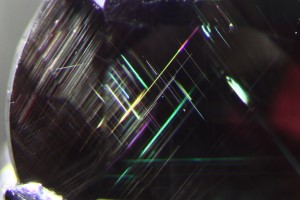
Rutile inclusions in a natural alexandrite reflect the light in bright colors
Foto: K. Sieber, www.makrogalerie.de
The special feature of alexandrite is the ability to change its color in artificial light. In daylight the gem always appears in green, bluish green or gray green colors. In artificial light with a priority of wavelengths in the yellow spectrum (e.g. candlelight) his color changes to blood-red or reddish violet. Responsible for this phenomenon is the element chromium which occurs - together with iron and titanium - as a trace element in the gem.
Fine Alexandrite, especially in sizes of more than one carat, is one of the most valuable gemstones. Its value depends primarily on the intensity of the color change. A very fine Alexandrite should be a vivid green in daylight and purple red without any brownish hue in incandescent light. The ability to change its color in different light sources is not limited to Alexandrites.
- »African Turquoise«
- Andara Crystal: a man-made artifical product
- Coated Gemstones
- Ye Ming Zhu - luminescent stones
- Diopside-Quartzite as »African Jade« or »Malachite Jade«
- Snakeskin Agate, Fire Agate and Fire Carnelian
- Larimar: Imitations and misnomers
- »Power Magnet« - an artificial industrial product
- POLYBERN in a new look
- »Rainbow Calsilica« - a colorful man-made rock




